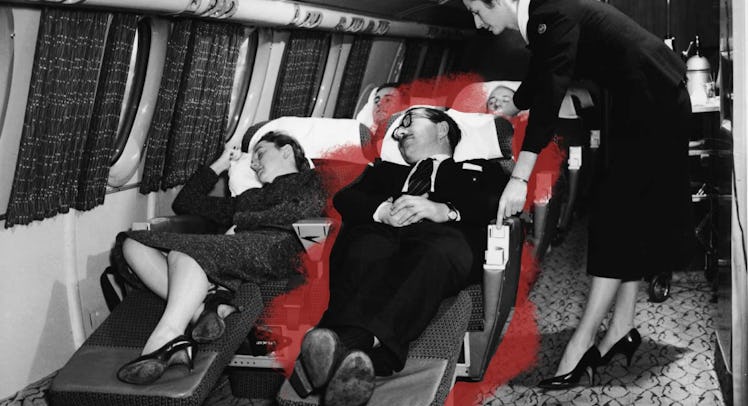Why Take The Red-Eye? Biphasic Sleep And Convenience
Scientists suspect that early humans seldom slept in single blocks of eight hours. So why not catch your Zzz's while in transit? Take the red-eye.

I catch the red-eye bus at least once a month. On those nights, I go to sleep in my cozy bed at 9 p.m. then wake up four hours later to take a bus from upstate New York to Manhattan. The moment the driver turns the ignition, I conk out. I barely stir until the bus pulls into Port Authority at 6 a.m. My colleagues shake their heads in wonder when I walk into the office with a smile on my face. No regimen could be more brutal, right?
Not exactly. I get nine hours of sleep when I take that bus. And that interruption in the middle is totally fine. I’m engaging in what scientists call biphasic sleep. It’s oddly refreshing.
Scientists and historians suspect that early humans seldom slept in single blocks of eight hours, as virtually all of us do now (and, admittedly, as the National Sleep Foundation recommends). Until the 19th century, historian Roger Ekirch writes, most people practiced biphasic sleep. They went to bed a few hours after nightfall, woke in the middle of the night to visit friends, get some work done, or have sex, and then went back to sleep for the remainder of the evening.
“The dominant pattern of sleep, arguably since time immemorial, was biphasic,” Ekirch told Live Science in 2011. “Humans slept in two four-hour blocks, which were separated by a period of wakefulness in the middle of the night lasting an hour or more.” Leonardo da Vinci, Thomas Edison, Nikola Tesla, Buckminster Fuller, and Margaret Thatcher are all rumored to have practiced polyphasic sleep, breaking up their evenings into waking and sleeping periods. And at least one study found that biphasic sleep seems to be our natural default. When exposed to natural light and dark cycles, without artificial lighting, adults tend to start sleeping in phases.
So I’m in good company. When I take the red-eye — whether it’s a bus, train, or plane — I’m tapping into my inner da Vinci or, heck, my own private Thatcher. I’m hearkening back to simpler times, before electricity busted my melatonin. Treating my body as it was meant to be treated.
Unless, of course, I’m not sleeping well when I snooze on the bus. Or unless my body is simply not calibrated to sleep in phases. Matt Bianchi, director of the sleep division at Massachusetts General Hospital, told Business Insider in 2013 that biphasic sleep isn’t for everyone. “Everyone is different,” he says. “Some people drink caffeine and get a rush while others don’t. One person might be fitted for polyphasic sleep, but someone else gets sleepy and crashes their car.”
And the claim that biphasic sleep is authentic because that’s how early humans snoozed is controversial among anthropologists. One 2015 study found that isolated hunter-gatherers sleep in single, short blocks of about six hours, much like humans in industrialized societies. “There’s this expectation that we should all be sleeping eight or nine hours a night and that if you took away modern technology people would be sleeping more,” said study co-author Gandhi Yetish of the University of New Mexico. “But now, for the first time, we’re showing that’s not true.”
The red-eye certainly is not for everyone. But if you find that biphasic sleep works for you — and you know that you can wake up with a smile after several hours of sleeping crumpled into the corner of a bus, train, or airplane — taking the red-eye isn’t a bad choice. Ticket prices tend to be less expensive, seats are usually less crowded, and you don’t lose a whole day in transit that you could be spending with your kid. Besides, Thomas Edison did it. Can it really be that bad?
This article was originally published on